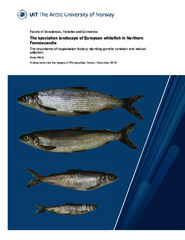| dc.contributor.advisor | Præbel, Kim | |
| dc.contributor.author | Häkli, Katja | |
| dc.date.accessioned | 2019-12-11T08:44:28Z | |
| dc.date.available | 2019-12-11T08:44:28Z | |
| dc.date.issued | 2019-12-10 | |
| dc.description.abstract | <p>During the last deglaciation, one clade of European whitefish (<i>Coregonus lavaretus</i> L.) colonized the lakes in the three contemporary watercourses of northern Fennoscandia (Pasvik, Tana and Alta) and diverged thereafter in sympatry. This thesis investigates the interplay between evolutionary processes and standing genetic variation in shaping phenotypic and genetic divergence, and how reproductive isolation is established and maintained in whitefish. In this thesis, I demonstrated how selection has shaped the whitefish population across a large spatial scale despite the clear effect of random genetic drift - presumably arising from the colonization history. The diversification of European whitefish follows a (non)parallel trajectory, as morphs in the different watercourses were characterised with various levels of phenotypic and genetic divergence, and signatures of both within and between lakes divergence were observed in all studies conducted within this thesis.
<p>As the reproductive isolation between whitefish eco-morph is not complete, hybridisation between morphs occurs frequently, which may refer relatively weak postzygotic barriers to gene flow between morphs. When whitefish morphs adapt to a specific niche, they encounter different environment conditions, like water temperature and prey availability that are important factors determining size at sexual maturity, somatic growth, and gonad development. Consequently, allochrony together with spatial differences in spawning may reinforces the ecological divergence and help to build up barriers to gene flow between the whitefish morphs. Indeed, allochrony seems to be working towards stronger reproductive isolation, as the advancement of the maturity, as well as the proportion of mature individuals differed between morphs.
<p>The results of this thesis are in line with the theory of ecological speciation and show how selection has shaped the European whitefish morphs towards stronger phenotype-environment correlation and more diversified populations, despite the decreasing amount of standing genetic variation between the three contemporary watercourses. Thus, the occurrence of whitefish morphs in the three watercourses may be an outcome of convergent evolution, where similar phenotypes have arisen from different genetic backgrounds. | en_US |
| dc.description.doctoraltype | ph.d. | en_US |
| dc.description.popularabstract | This thesis investigates the interplay between evolutionary processes and standing genetic variation in shaping phenotypic and genetic divergence, and how reproductive isolation is established and maintained in European whitefish (<i>Coregonus lavaretus</i> L.). Whitefish samples were collected from 36 lakes in three watercourses harbouring mono or polymorphic whitefish populations in northern Fennoscandia. The results of this thesis are in line with the theory of ecological speciation and show how selection has shaped the European whitefish morphs towards stronger phenotype-environment correlation and more diversified populations, despite the decreasing amount of standing genetic variation between the three contemporary watercourses. Thus, the occurrence of whitefish morphs in the three watercourses may be an outcome of convergent evolution, where similar phenotypes have arisen from different genetic backgrounds. | en_US |
| dc.description.sponsorship | I would like to thank UiT, The Arctic University of Norway for funding my PhD | en_US |
| dc.identifier.isbn | 978-82-8266-172-0 | |
| dc.identifier.uri | https://hdl.handle.net/10037/16887 | |
| dc.language.iso | eng | en_US |
| dc.publisher | UiT The Arctic University of Norway | en_US |
| dc.publisher | UiT Norges arktiske universitet | en_US |
| dc.relation.haspart | <p>Paper I: Häkli, K., Østbye, K., Kahilainen, K.K., Amundsen, P.-A. & Praebel, K. (2018). Diversifying selection drives parallel evolution of gill raker number and body size along the speciation continuum of European whitefish. <i>Ecology and evolution, 8</i>(5), 2617-2631. Also available in Munin at <a href= https://hdl.handle.net/10037/13390> https://hdl.handle.net/10037/13390</a>.
<p>Paper II: Häkli, K., Bhat, S., Siwertsson, A., Knudsen, R., Amundsen, P.-A., Kahilainen, K.K., Østbye, K. & Præbel, K. (Non)parallel patterns of standing genetic variation and phenotypic diversity in a speciation continuum of European whitefish in northern Fennoscandia (Manuscript).
<p>Paper III: Bitz‐Thorsen, J., Häkli, K., Bhat, S. & Præbel, K. (2019). Allochrony as a potential driver for reproductive isolation in adaptive radiations of European whitefish ecomorphs. <i>Ecology of Freshwater Fish</i>. Also available at <a href=https://doi.org/10.1111/eff.12486> https://doi.org/10.1111/eff.12486</a>. Accepted manuscript version available in Munin at <a href= https://hdl.handle.net/10037/16635> https://hdl.handle.net/10037/16635</a>. | en_US |
| dc.relation.isbasedon | Bitz-Thorsen, J., Häkli, K., Bhat, S. & Præbel, K. (2019). Replication data for: Allochrony as a potential driver for reproductive isolation in adaptive radiations of European whitefish ecomorphs. <a href=https://doi.org/10.18710/CGZDTP>https://doi.org/10.18710/CGZDTP</a>. DataverseNO, V1, UNF:6:qE0ntQe8Wk46ViKAK6RkDA== [fileUNF] | en_US |
| dc.relation.isbasedon | Häkli, K., Østbye, K., Kahilainen, K.K., Amundsen, P. & Præbel, K. (2018). Data from: Diversifying selection drives parallel evolution of gill raker number and body size along the speciation continuum of European whitefish. Dryad Digital Repository. <a href=https://doi.org/10.5061/dryad.rr7v5>https://doi.org/10.5061/dryad.rr7v5</a>. | en_US |
| dc.rights.accessRights | openAccess | en_US |
| dc.rights.holder | Copyright 2019 The Author(s) | |
| dc.subject.courseID | DOKTOR-002 | |
| dc.subject | VDP::Mathematics and natural science: 400::Basic biosciences: 470::Genetics and genomics: 474 | en_US |
| dc.subject | VDP::Matematikk og Naturvitenskap: 400::Basale biofag: 470::Genetikk og genomikk: 474 | en_US |
| dc.subject | VDP::Mathematics and natural science: 400::Basic biosciences: 470::Molecular biology: 473 | en_US |
| dc.subject | VDP::Matematikk og Naturvitenskap: 400::Basale biofag: 470::Molekylærbiologi: 473 | en_US |
| dc.subject | VDP::Mathematics and natural science: 400::Zoology and botany: 480::Ecology: 488 | en_US |
| dc.subject | VDP::Matematikk og Naturvitenskap: 400::Zoologiske og botaniske fag: 480::Økologi: 488 | en_US |
| dc.title | The speciation landscape of European whitefish in Northern Fennoscandia – the importance of deglaciation history, standing genetic variation and natural selection | en_US |
| dc.type | Doctoral thesis | en_US |
| dc.type | Doktorgradsavhandling | en_US |


 English
English norsk
norsk
